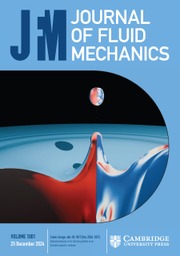Crossref Citations
This article has been cited by the following publications. This list is generated based on data provided by
Crossref.
Gabard, C.
and
Hulin, J.-P.
2003.
Miscible displacement of non-Newtonian fluids in a vertical tube.
The European Physical Journal E,
Vol. 11,
Issue. 3,
p.
231.
Poiré, E Corvera
and
Río, J A del
2004.
Viscoelastic fingering with a pulsed pressure signal.
Journal of Physics: Condensed Matter,
Vol. 16,
Issue. 22,
p.
S2055.
Fast, Petri
and
Shelley, Michael J
2004.
A moving overset grid method for interface dynamics applied to non-Newtonian Hele–Shaw flow.
Journal of Computational Physics,
Vol. 195,
Issue. 1,
p.
117.
Yamamoto, Takehiro
Suga, Takanori
Nakamura, Kiyoji
and
Mori, Noriyasu
2004.
The Gas Penetration Through Viscoelastic Fluids With Shear-Thinning Viscosity in a Tube.
Journal of Fluids Engineering,
Vol. 126,
Issue. 2,
p.
148.
Dimakopoulos, Yannis
and
Tsamopoulos, John
2004.
On the gas-penetration in straight tubes completely filled with a viscoelastic fluid.
Journal of Non-Newtonian Fluid Mechanics,
Vol. 117,
Issue. 2-3,
p.
117.
Wysocki, A
and
Löwen, H
2004.
Instability of a fluid–fluid interface in driven colloidal mixtures.
Journal of Physics: Condensed Matter,
Vol. 16,
Issue. 41,
p.
7209.
Toussaint, R
Løvoll, G
Méheust, Y
Måløy, K. J
and
Schmittbuhl, J
2005.
Influence of pore-scale disorder on viscous fingering during drainage.
Europhysics Letters (EPL),
Vol. 71,
Issue. 4,
p.
583.
Amar, Martine Ben
and
Bonn, Daniel
2005.
Fingering instabilities in adhesive failure.
Physica D: Nonlinear Phenomena,
Vol. 209,
Issue. 1-4,
p.
1.
Bonn, Daniel
Amarouchène, Yacine
Wagner, Christian
Douady, Stéphane
and
Cadot, Olivier
2005.
Turbulent drag reduction by polymers.
Journal of Physics: Condensed Matter,
Vol. 17,
Issue. 14,
p.
S1195.
Bhatara, Gandharv
Shaqfeh, Eric S. G.
and
Khomami, Bamin
2005.
The influence of polymer concentration and chain architecture on free surface displacement flows of polymeric fluids.
Journal of Rheology,
Vol. 49,
Issue. 5,
p.
929.
Maleki-Jirsaraei, Nahid
Lindner, Anke
Rouhani, Shahin
and
Bonn, Daniel
2005.
Saffman–Taylor instability in yield stress fluids.
Journal of Physics: Condensed Matter,
Vol. 17,
Issue. 14,
p.
S1219.
YAMAMOTO, Takehiro
KIMOTO, Ryusuke
and
MORI, Noriyasu
2005.
Tip Velocity of Viscous Fingers in Shear-Thinning Fluids in a Hele-Shaw Cell.
JSME International Journal Series B,
Vol. 48,
Issue. 4,
p.
756.
Xu, Mingyu
and
Tan, Wenchang
2006.
Intermediate processes and critical phenomena: Theory, method and progress of fractional operators and their applications to modern mechanics.
Science in China Series G,
Vol. 49,
Issue. 3,
p.
257.
Johnsen, Ø.
Toussaint, R.
Måløy, K. J.
and
Flekkøy, E. G.
2006.
Pattern formation during air injection into granular materials confined in a circular Hele-Shaw cell.
Physical Review E,
Vol. 74,
Issue. 1,
Chevalier, C.
Lindner, A.
and
Clément, E.
2007.
Destabilization of a Saffman-Taylor Fingerlike Pattern in a Granular Suspension.
Physical Review Letters,
Vol. 99,
Issue. 17,
NAGATSU, YUICHIRO
MATSUDA, KENJI
KATO, YOSHIHITO
and
TADA, YUTAKA
2007.
Experimental study on miscible viscous fingering involving viscosity changes induced by variations in chemical species concentrations due to chemical reactions.
Journal of Fluid Mechanics,
Vol. 571,
Issue. ,
p.
475.
Tordjeman, Ph.
2007.
Saffman-Taylor instability of shear thinning fluids.
Physics of Fluids,
Vol. 19,
Issue. 11,
Cheng, Xiang
Xu, Lei
Patterson, Aaron
Jaeger, Heinrich M.
and
Nagel, Sidney R.
2008.
Towards the zero-surface-tension limit in granular fingering instability.
Nature Physics,
Vol. 4,
Issue. 3,
p.
234.
Johnsen, Ø.
Chevalier, C.
Lindner, A.
Toussaint, R.
Clément, E.
Måløy, K. J.
Flekkøy, E. G.
and
Schmittbuhl, J.
2008.
Decompaction and fluidization of a saturated and confined granular medium by injection of a viscous liquid or gas.
Physical Review E,
Vol. 78,
Issue. 5,
Daripa, Prabir
2008.
Hydrodynamic stability of multi-layer Hele-Shaw flows.
Journal of Statistical Mechanics: Theory and Experiment,
Vol. 2008,
Issue. 12,
p.
P12005.


